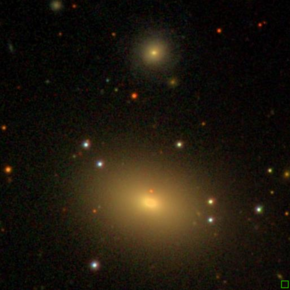| NGC 499 | |
|---|---|
 | |
| Observation data (J2000[1] epoch) | |
| Constellation | Pisces[2] |
| Right ascension | 01h 23m 11.5s[3] |
| Declination | +33° 27′ 28″[3] |
| Redshift | +0.014691 ± 0.000117[1] |
| Heliocentric radial velocity | (4372 ± 35.2) km/s[1] |
| Distance | 197 Mly[4] |
| Apparent magnitude (V) | 12.2[2] |
| Characteristics | |
| Type | E-S0[2] |
| Apparent size (V) | 1.7' × 1.3'[2] |
| Other designations | |
| PGC 5060, IC 1686, UGC 926, GC 289, MCG 5-4-38, 2MASS J01231145+3327362, H 3.158, h 106, CGCG 502-059[2][1][5] | |
Preview warning: Page using Template:Infobox galaxy with unknown parameter "image_size"
NGC 499, also occasionally referred to as PGC 5060, IC 1686 or GC 289, is a lenticular galaxy in the constellation Pisces.[2] It is located approximately 197 million light-years from the Solar System[4] and was discovered on 12 September, 1784 by astronomer William Herschel.[5]
The NGC 499 Group is named after the galaxy.[3]
- ^ a b c d "NGC 499". SIMBAD. Centre de données astronomiques de Strasbourg. Retrieved 2017-11-07.
- ^ a b c d e f "Revised NGC Data for NGC 499". spider.seds.org. Retrieved 2017-10-05.
- ^ a b c "Your NED Search Results". ned.ipac.caltech.edu. Retrieved 2017-11-07.
- ^ a b An object's distance from Earth can be determined using Hubble's law: v=Ho is Hubble's constant (70±5 (km/s)/Mpc). The relative uncertainty Δd/d divided by the distance is equal to the sum of the relative uncertainties of the velocity and v=Ho
- ^ a b "New General Catalog Objects: NGC 450 - 499". cseligman.com. Retrieved 2017-11-07.